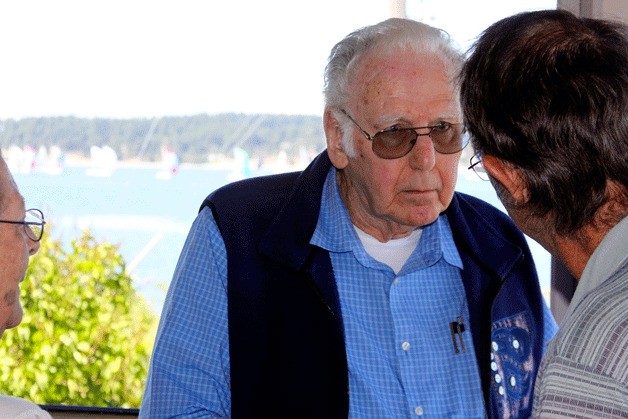For the sake of delivering a talk about maritime history last week, Roger Sherman left the comforts of his own home and addressed a small group on the porch of the Island County Museum.
With sailboats from Whidbey Island’s Race Week serving as a backdrop in Penn Cove, the setting couldn’t have been much more perfect.
What most of the 20 or so people who gathered at the museum didn’t realize, however, is that Sherman doesn’t have to leave his house to get an intimate feel for the island’s nautical past.
Although his home offers a view of the vessels that pass through Admiralty Inlet, Sherman gets the ultimate experience from his ground-floor den.
In 1996, he had the mostly bare room remodeled, transforming it into what resembles the officer’s quarters of a 19th century square-rig sailing ship.
Sherman had collected so many nautical artifacts over the years that he needed a place to display some and store others, so he and his wife Darlene reached a compromise, resulting in the elaborate remodel.
“At the time, she would’ve rather had a new kitchen,” Sherman said. “She humored me.”
Two years later, Sherman self-published 1,500 copies of a book that was mostly about Whidbey Island’s maritime history and partly about a story that had been passed down in his family.

The book, “The Sinking of the Calista, Part 1 of a Maritime History of Central Whidbey Island,” was one of the topics that brought Sherman to downtown Coupeville as part of the museum’s “Porch Stories” series last Wednesday.
Eighteen years later, there is talk about Part 2.
“Everyone’s been bugging him since he wrote, ‘The Sinking of the Calista,’ because he put part one on there,” Rick Castellano, the museum’s executive director, told the group.
“That was definitely a mistake,” Sherman said, drawing hardy laughter.
“I’m not very fast,” he said later.
Sherman, 81, said he’s about 40 percent done with the second book and will finish it as long as his health allows.
He wants to go into more depth about the island’s maritime past, including the role of Ebey’s Landing and the island’s fishing resorts, among other topics.
The first book devoted chapters to early island transportation and the Mosquito Fleet but put much of its focus on the Calista, a Coupeville-based steamer that ran the Seattle-to-Whidbey route from 1911 to 1922, carrying passengers and freight.
In the late morning of July 27, 1922, the Calista entered a thick fog as it approached Seattle and was struck by a Japanese freighter. It sank in 28 minutes but all 75 people on board survived, including members of Sherman’s extended family.
The tale gripped Sherman’s fascination in maritime history. Although he spent his career as a farmer, he also helped lead a Boy Scouts of America Sea Explorer program for more than 25 years.
Castellano considers him one of the island’s resident experts on maritime history. He’s seen Sherman’s den, which includes four ship wheels, including one from an old ferry that used to travel from North Whidbey to Camano Island known as the Acorn. The walls and arched ceiling are custom made using oak. There are port lights that illuminate historic photos.
“I’m really proud of him,” Al Sherman said of his brother. “He does a lot of research.”
And he’s evened the score with his wife, too, as evidenced by another remodel upstairs.
“She got her kitchen,” Roger Sherman said.

